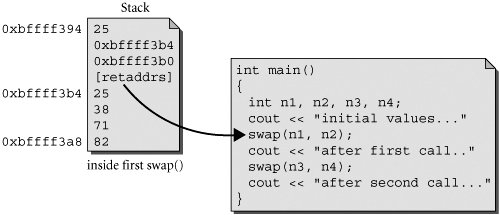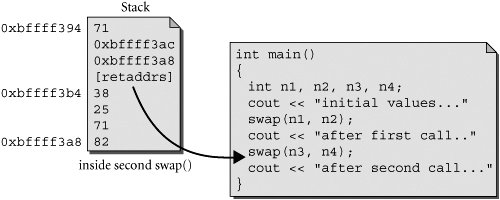Parameter Passing by Reference
Large objects, or objects with expensive copy constructors, should not be passed by value because the creation of temporary copies consumes time, machine cycles, and memory needlessly. In C, we passed objects by pointer to avoid copying them. However, using pointers requires a different syntax from using regular variables. Further, accidental misuse of pointers can cause data corruption, leading to runtime errors that can be very difficult to find and fix. In C++ (and C99), we can pass by reference, which offers the same performance as a pointer-pass. With objects, this permits use of the (.) operator for accessing members.
A reference parameter is simply a parameter that is an alias for something else. To declare a parameter to be a reference, put the ampersand character (&) between the type name and the parameter name.
A reference parameter of a function is initialized by the actual argument being passed when the function is called. That argument must be, as with any reference, a non-const lvalue. Changes to a non-const reference parameter in the function cause changes to the actual object used to initialize the parameter. This feature is often exploited to allow functions, which can return at most one value, to cause changes in several objects, effectively allowing the function to return several values. Example 5.13 shows how reference parameters can be used with integers.
Example 5.13. src/reference/swap.cpp
#include
using namespace std;
void swap(int &a, int &b) {
int temp = a;
cout << "Inside the swap() function:
"
<< "address of a: " << &a
<< " address of b: " << &b
<< "
address of temp: " << &temp << endl;
a = b;
b = temp;
}
int main() {
int n1 = 25;
int n2 = 38;
int n3 = 71;
int n4 = 82;
cout << "Initial values:
"
<< "address of n1: " << &n1
<< " address of n2: " << &n2
<< "
value of n1: " << n1
<< " value of n2: " << n2
<< "
address of n3: " << &n3
<< " address of n4: " << &n4
<< "
value of n3: " << n3
<< " value of n4: " << n4
<< "
Making the first call to swap()" << endl;
swap(n1,n2);
cout << "After the first call to swap():
"
<< "address of n1: " << &n1
<< " address of n2: " << &n2
<< "
value of n1: " << n1
<< " value of n2: " << n2
<< "
Making the second call to swap()" << endl;
swap(n3,n4);
cout << "After the second call to swap():
"
<< "address of n3: " << &n3
<< " address of n4: " << &n4
<< "
value of n3: " << n3
<< " value of n4: " << n4 << endl;
return 0;
}
|
There are extra output statements in Example 5.13 to help keep track of the addresses of the important variables.
Initial values: address of n1: 0xbffff3b4 address of n2: 0xbffff3b0 value of n1: 25 value of n2: 38 address of n3: 0xbffff3ac address of n4: 0xbffff3a8 value of n3: 71 value of n4: 82
Initially our stack might look something like Figure 5.1:
Figure 5.1. Before first swap()

As the program proceeds, we will see output like this:
Making the first call to swap() Inside the swap() function: address of a: 0xbffff3b4 address of b: 0xbffff3b0 address of temp: 0xbffff394
When references get passed to functions, the values that get pushed onto the stack are addresses, not values. Under the covers, pass-by-reference is very much like pass-by-pointer. Our stack now might look like Figure 5.2:
Figure 5.2. Inside first swap()

After the first call to swap(): address of n1: 0xbffff3b4 address of n2: 0xbffff3b0 value of n1: 38 value of n2: 25 Making the second call to swap() Inside the swap() function:
Now our stack might look like Figure 5.3:
Figure 5.3. Inside second swap()

address of a: 0xbffff3ac address of b: 0xbffff3a8 address of temp: 0xbffff394 After the second call to swap(): address of n3: 0xbffff3ac address of n4: 0xbffff3a8 value of n3: 82 value of n4: 71
The swap() function is actually working with n1 and n2 during the first call and with n3 and n4 during the second call.
Pass-by-reference is an alternate syntax for passing by pointer. Under the covers, it is implemented the same way (i.e., the value is not copied). The main difference between pass-by-pointer and pass-by-reference is that you must de-reference a pointer, while a reference is accessible in the same way as the referred "thing."
Pass-by-Pointer or Pass-by-Reference?

When you have a choice, it is generally preferable to use references instead of pointers because this can reduce the number of places where a programmer can accidentally corrupt memory. It is only when you need to manage objects (creation, destruction, adding to a managed container) that you need to operate on pointers, and those routines can usually be encapsulated as member functions.
References to const |
Part I: Introduction to C++ and Qt 4
C++ Introduction
- C++ Introduction
- Overview of C++
- A Brief History of C++
- Setup: Open-Source Platforms
- Setup: Win32
- C++ First Example
- Input and Output
- Identifiers, Types, and Literals
- C++ Simple Types
- C++ Standard Library Strings
- Streams
- The Keyword const
- Pointers and Memory Access
- const* and *const
- Reference Variables
- Points of Departure
- Review Questions
Classes
- Classes
- Structs
- Class Definitions
- Member Access Specifiers
- Encapsulation
- Introduction to UML
- Friends of a Class
- Constructors
- Subobjects
- Destructors
- The Keyword static
- Copy Constructors and Assignment Operators
- Conversions
- const Member Functions
- Review Questions
Introduction to Qt
- Introduction to Qt
- Example Project: Using QApplication and QLabel
- Makefile, qmake, and Project Files
- Getting Help Online
- Style Guidelines and Naming Conventions
- The Qt Core Module
- Streams and Dates
- Points of Departure
- Review Questions
Lists
Functions
- Functions
- Function Declarations
- Overloading Functions
- Optional Arguments
- Operator Overloading
- Parameter Passing by Value
- Parameter Passing by Reference
- References to const
- Function Return Values
- Returning References from Functions
- Overloading on const-ness
- Inline Functions
- Inlining versus Macro Expansion
- Review Questions
Inheritance and Polymorphism
- Inheritance and Polymorphism
- Simple Derivation
- Derivation with Polymorphism
- Derivation from an Abstract Base Class
- Inheritance Design
- Overloading, Hiding, and Overriding
- Constructors, Destructors, and Copy Assignment Operators
- Processing Command-Line Arguments
- Points of Departure
- Review Questions
Part II: Higher-Level Programming
Libraries
- Libraries
- Code Containers
- Reusing Other Libraries
- Organizing Libraries: Dependency Management
- Installing Libraries: A Lab Exercise
- Frameworks and Components
- Review Questions
Introduction to Design Patterns
QObject
- QObject
- QObjects Child Managment
- Composite Pattern: Parents and Children
- QApplication and the Event Loop
- Q_OBJECT and moc: A Checklist
- Values and Objects
- tr() and Internationalization
- Point of Departure
- Review Questions
Generics and Containers
- Generics and Containers
- Generics and Templates
- Containers
- Managed Containers, Composites, and Aggregates
- Implicitly Shared Classes
- Generics, Algorithms, and Operators
- Serializer Pattern
- Sorted Map Example
- Review Questions
Qt GUI Widgets
- Qt GUI Widgets
- Widget Categories
- QMainWindow and QSettings
- Dialogs
- Images and Resources
- Layout of Widgets
- QActions, QMenus, and QMenuBars
- QActions, QToolbars, and QActionGroups
- Regions and QDockWidgets
- Views of a QStringList
- Points of Departure
- Review Questions
Concurrency
- Concurrency
- QProcess and Process Control
- Threads and QThread
- Summary: QProcess and QThread
- Review Questions
Validation and Regular Expressions
- Validation and Regular Expressions
- Validators
- Regular Expressions
- Regular Expression Validation
- Review Questions
Parsing XML
Meta Objects, Properties, and Reflective Programming
- Meta Objects, Properties, and Reflective Programming
- Anti-patterns
- QMetaObject: The MetaObject Pattern
- Type Identification and qobject_cast
- Q_PROPERTY Macro: Describing QObject Properties
- QVariant Class: Accessing Properties
- DataObject: An Extension of QObject
- Property Containers: PropsMap
- Review Questions
More Design Patterns
- More Design Patterns
- Creational Patterns
- Serializer Pattern Revisited
- The Façade Pattern
- Points of Departure
- Review Questions
Models and Views
- Models and Views
- M-V-C: What about the Controller?
- Dynamic Form Models
- Qt 4 Models and Views
- Table Models
- Tree Models
- Review Questions
Qt SQL Classes
Part III: C++ Language Reference
Types and Expressions
- Types and Expressions
- Operators
- Evaluation of Logical Expressions
- Enumerations
- Signed and Unsigned Integral Types
- Standard Expression Conversions
- Explicit Conversions
- Safer Typecasting Using ANSI C++ Typecasts
- Run-Time Type Identification (RTTI)
- Member Selection Operators
- Point of Departure
- Review Questions
Scope and Storage Class
- Scope and Storage Class
- Declarations and Definitions
- Identifier Scope
- Storage Class
- Namespaces
- Review Questions
Statements and Control Structures
Memory Access
- Memory Access
- Pointer Pathology
- Further Pointer Pathology with Heap Memory
- Memory Access Summary
- Introduction to Arrays
- Pointer Arithmetic
- Arrays, Functions, and Return Values
- Different Kinds of Arrays
- Valid Pointer Operations
- What Happens If new Fails?
Chapter Summary
Inheritance in Detail
- Inheritance in Detail
- Virtual Pointers and Virtual Tables
- Polymorphism and virtual Destructors
- Multiple Inheritance
- Point of Departure
- public, protected, and private Derivation
- Review Questions
Miscellaneous Topics
Part IV: Programming Assignments
MP3 Jukebox Assignments
- MP3 Jukebox Assignments
- Data Model: Mp3File
- Visitor: Generating Playlists
- Preference: An Enumerated Type
- Reusing id3lib
- PlayListModel Serialization
- Testing Mp3File Related Classes
- Simple Queries and Filters
- Mp3PlayerView
- Models and Views: PlayList
- Source Selector
- Persistent Settings
- Edit Form View for FileTagger
- Points of Departure
Part V: Appendices
MP3 Jukebox Assignments
- MP3 Jukebox Assignments
- Appendix A. C++ Reserved Keywords
- Appendix B. Standard Headers
- Appendix C. The Development Environment
- Section C.1. The Preprocessor: For #including Files
- Section C.2. Understanding the Linker
- Section C.3. Debugging
- Section C.4. Qt Assistant and Designer
- Section C.5. Open-Source IDEs and Development Tools
Bibliography
MP3 Jukebox Assignments
EAN: 2147483647
Pages: 268
